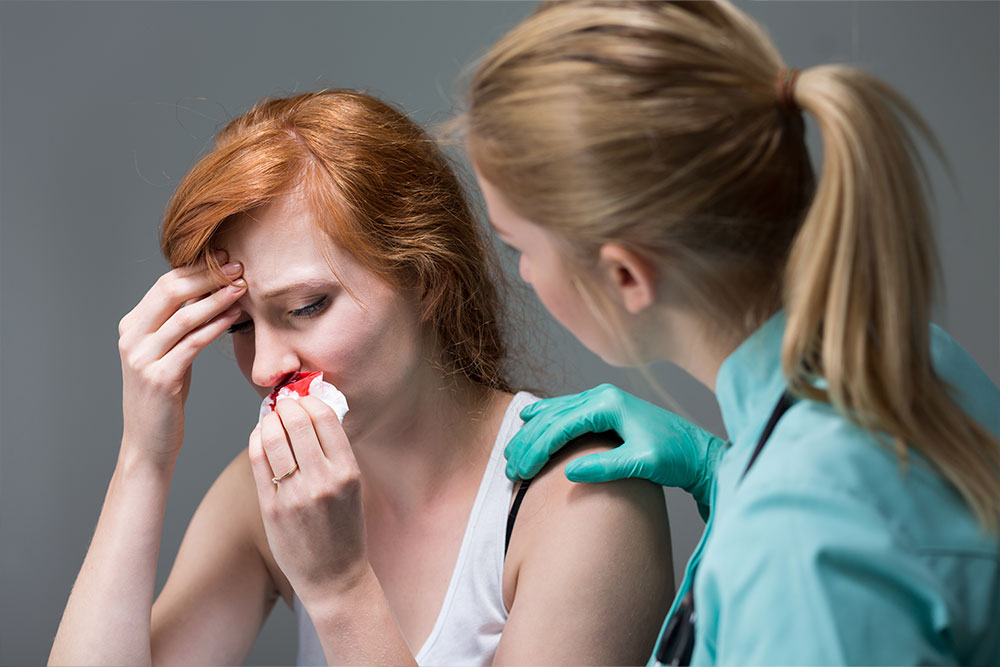
Most of us have had a nosebleed or had to help someone with a nosebleed at some point. Sometimes, a nosebleed can happen because of an accident; occasionally, it just seems to occur for no reason.
In most cases, a common nosebleed isn’t severe, but it can be distressing. Knowing how to provide effective first aid for a bleeding nose can help stop blood flow quickly. It’s a basic first-aid technique that everyone should know.
In this article, we’ll explain the steps for providing first aid for a bleeding nose. So, the next time you have a nosebleed or someone near you has one, you’ll know exactly what to do.
What Causes Nosebleeds?
Nosebleeds can happen to kids and adults alike. Sometimes, the causes of nosebleeds are apparent, like falling off a bike, getting your nose whacked in a rugby game, or doing something silly like walking into a door. But at other times, our noses seem to spout blood for no apparent reason. So, what are common nosebleed causes?
Your nose contains delicate blood vessels that can be easily damaged. When these tiny little blood vessels rupture, they can release an astonishing amount of blood. And quite a few things can cause our nasal blood vessels to break.
Dry air is a typical cause of nosebleeds. Hot or humid air causes our noses to dry out, so those little blood vessels can rupture more easily. We’re more prone to nosebleeds in hot, humid climates or when the heating is on in winter.
Other common causes of nosebleeds include:
- Blowing your nose too hard
- Accidents
- Picking your nose
- Allergies
- Being at a high altitude
- Blood thinning medication
- Illegal drug use
- Alcohol abuse
- Decongestant and corticosteroid use
- Oxygen therapy
- Medical conditions
- Surgery
How Serious Is a Nosebleed?
In most cases, a nosebleed isn’t cause for alarm. With the proper first aid treatment and some time, most nosebleeds simply stop.
But there are situations where a nosebleed can be much more than just a minor irritation. If the blood flow is exceptionally heavy and doesn’t stop after a short while, the person may need medical treatment.
People can lose a significant amount of blood during a severe nosebleed. In drastic scenarios, this can cause anaemia or even lead to cardiac arrest.
While they may seem like an everyday occurrence, people have died from nosebleeds. A 47-year-old man in Kent died in 2011 after suffering a severe nosebleed. In 2016, a 34-year-old man passed away in a hospital in Dublin after a significant nosebleed caused him to go into cardiac arrest. There’s even been a case where doctors believed someone died due to bleeding caused by excessive nose-picking.
So, while most nosebleeds aren’t life-threatening, they should always be taken seriously. Apart from being unpleasant and somewhat distressing for the person with the nosebleed, there’s always the chance that things could take a nasty turn for the worse. That’s why you should know the steps for first aid for a bleeding nose.
How to Provide First Aid for a Bleeding Nose
Providing first aid for bleeding noses isn’t a complicated process. Given how common nosebleeds are, this first aid technique should be taught to everyone, children and adults.

If you or someone around you has a nosebleed, just follow the below four steps:
Step One: Stay Calm
Having blood dripping out of your face isn’t an enjoyable experience. Many people experience a high level of distress during a nosebleed. The torrents of blood can also be highly distressing for the people providing first aid. Some people may even go into a state of shock.
Whether experiencing a nosebleed or giving first aid, it’s essential to remain calm. Going into a hyper-agitated state can increase the rate of bleeding. Stay focused and try to calm yourself or the person you’re helping.
Step Two: Sit Up and Lean with the Head Forward
Lying down is a definite no-no during a nosebleed. Putting your head between your knees is also not a good idea. The person with a nosebleed should sit upright, keeping their head above their heart. Lean the head forward slightly to stop blood from draining down the back of the throat.
Step Three: Pinch the Nostrils Closed
The next step is to firmly pinch the soft area of your nose just above the nostrils and breathe through your mouth. This restricts the blood flow. You can also place a cold compress on the bridge of the nose to further decrease the blood flow. It’s important not to stop pinching the nostrils while you do this, however.
Step Four: Repeat Every Ten to Fifteen Minutes
After ten to fifteen minutes, the person should stop pinching their nose to see if the blood flow has eased. If the blood is still flowing, repeat the process for another ten to fifteen minutes.
What to Do After a Nosebleed
After the blood flow stops, the person should lean forward slightly and gently have the area around the nose cleaned. Use lukewarm water to remove the blood from the face.
Once the nosebleed has stopped, the person can gently blow their nose to remove clots. This should not be done repeatedly. Avoid blowing the nose again or picking it for at least 24 hours. The person who has had the nosebleed should also avoid hot beverages, alcoholic drinks, exercise or heavy lifting for 24 hours. If possible, try to stay upright for as long as possible. Lying down can cause the nasal blood vessels to rupture again after a nosebleed.
When to Seek Medical Attention for a Nosebleed
Most nosebleeds can be resolved by following the steps above. But, there are a few scenarios where seeking emergency medical attention is advisable. Get help right away if:
- A nosebleed lasts for longer than 30 minutes
- A child under two has a nosebleed
- The blood flow is particularly heavy
- The person has been in an accident or suffered a severe injury
- The person is vomiting
- The person is taking blood-thinning medication
- The person has a medical condition such as haemophilia
- The person is experiencing regular nosebleeds
Where to Find Further First Aid Training
Treating a nosebleed is a simple and effective form of first aid that anyone can learn. But it’s also a good idea to develop your first aid skills. Knowing how to provide essential first aid treatment can make all the difference in an emergency. If someone is injured or falls ill, quick action from a trained first aider could save their life.
In the UK, employers are legally obliged to ensure that their place of business has adequate first aid facilities and that trained first aid personnel are on staff.
Our First Aid at Work Course covers all the first aid essentials. Although it isn’t designed to replace practical first-aid training, it will help you cope in an emergency, whether dealing with a nosebleed or something more serious.


















































































































































































































































































































































































































































































































































































































































































































































